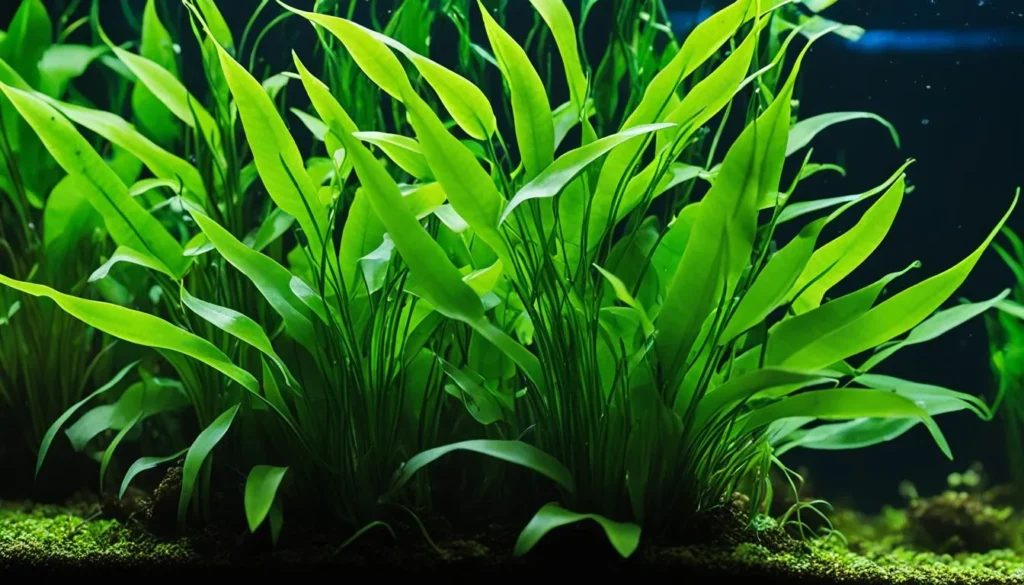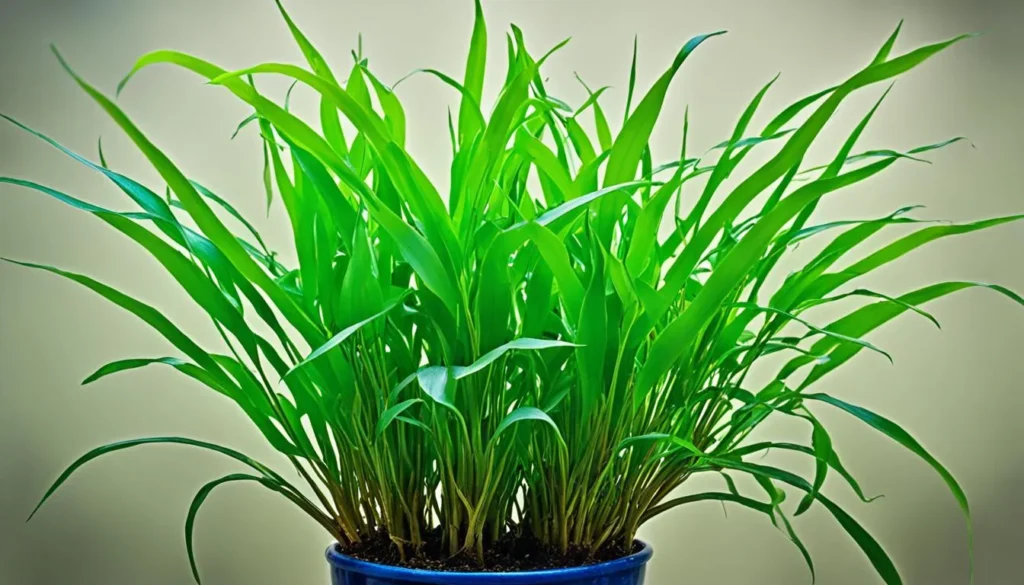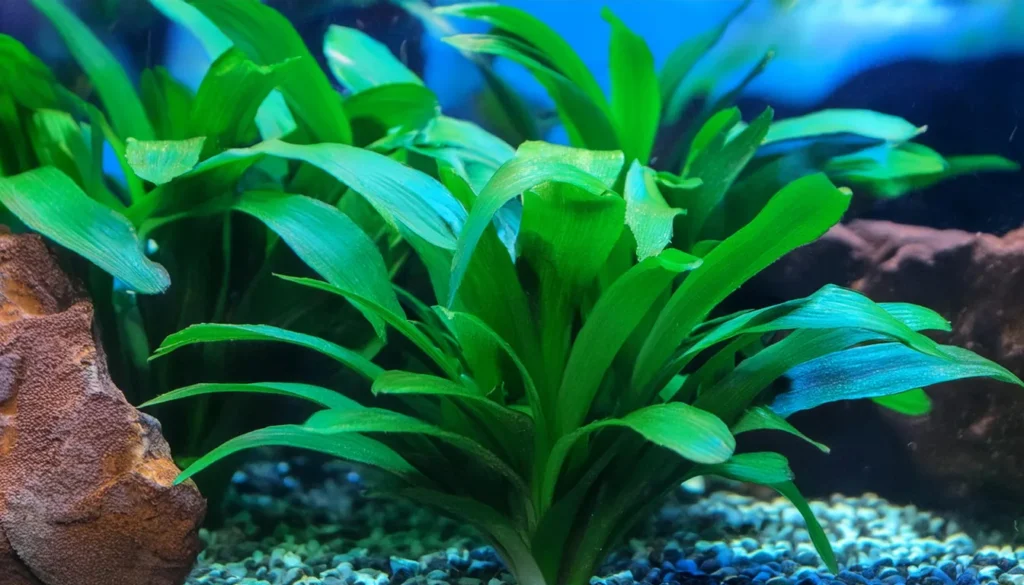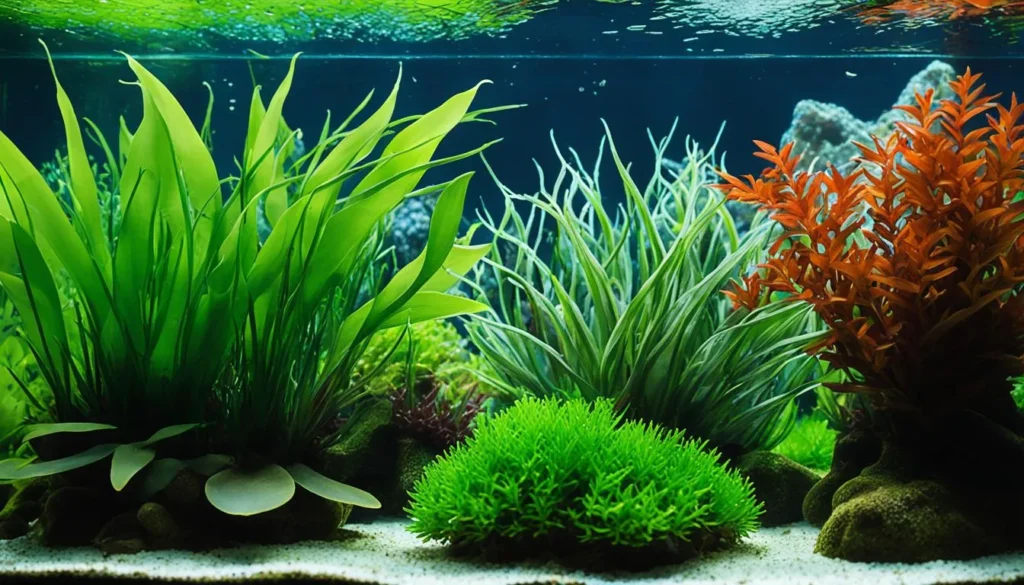Cryptocoryne wendtii green is a stunning aquatic plant that is highly sought after by aquarium enthusiasts. Its vibrant green color and beautiful leaf shape make it a standout addition to any aquarium.
In this article, we will explore the various aspects of Cryptocoryne wendtii green, including its characteristics, care requirements, growth patterns, and role in aquascaping.
Whether you’re a beginner or an experienced hobbyist, Cryptocoryne wendtii green is sure to impress with its unmatched elegance and adaptability.

Key Takeaway
- Cryptocoryne wendtii green is a highly sought-after aquatic plant known for its vibrant green color and beautiful leaf shape.
- It is a versatile plant that can thrive in a wide range of aquarium conditions, making it suitable for both beginners and experienced aquarists.
- Care requirements for Cryptocoryne wendtii green are relatively low, but maintaining stable water conditions and providing a nutrient-rich substrate are important for its overall health and growth.
- This plant is an excellent choice for mid-ground placement in an aquascape. It adds visual interest and provides shelter for fish.
- With its slow growth rate and adaptability to low-light conditions, Cryptocoryne wendtii green is an ideal option for beginners looking to enhance their aquariums with a touch of elegance.
Quick Stats
| Attribute | Details |
| Family Name | Araceae |
| Origin | Sri Lanka |
| Height | 10-15 cm (4-6 inches), can reach up to 20 cm (8 inches) in ideal conditions |
| pH Range | 5.5 – 8.0 |
| CO2 Requirement | Low |
| Growth Rate | Moderate |
| Care Level | Easy |
| Color Form | Green, with robust and broad leaves |
| Water Conditions | 22-28°C (72-82°F), adaptable to a wide range of hardness |
| Max Size | Leaves up to 20 cm (8 inches) long |
| Lighting | Low to Moderate |
| Supplements | Benefits from root tabs and liquid fertilizers |
| Placement | Foreground to Mid-ground |
| Propagation | By runners |
What Is Cryptocoryne Wendtii Green?
Cryptocoryne wendtii green is a popular species of Cryptocoryne plant that originated from Sri Lanka. It belongs to the Araceae family and is commonly called the “green gecko” due to its vibrant green color and unique leaf shape.
This plant is highly versatile and can thrive in a wide range of aquarium conditions, making it a favorite choice among beginner and experienced aquarists.
Its striking appearance and ease of care make it an ideal choice for adding a touch of elegance to any aquarium.
Natural Habitat And Origin
Cryptocoryne wendtii green originates from the island of Sri Lanka in South Asia. In its natural habitat, it thrives in the shallow waters of streams, rivers, and marshes, often growing submerged or partially submerged along the banks.
Sri Lanka’s tropical climate provides the ideal conditions for Cryptocoryne wendtii green to flourish, with warm temperatures, ample sunlight, and nutrient-rich sediment.
These plants are typically found in areas with moderate water flow and soft to moderately hard water conditions.

Distinguishing Features Of Cryptocoryne Wendtii
- The distinguishing feature of Cryptocoryne wendtii is its unique ability to change its leaf shape and color depending on the surrounding conditions. This remarkable adaptability makes it a captivating plant for aquarium enthusiasts.
- Cryptocoryne wendtii typically exhibits elongated, lance-shaped leaves when exposed to low light. The leaves may become broader in brighter conditions and take on an attractive oval shape.
- The vibrant green color of Cryptocoryne wendtii leaves adds a lively and refreshing element to any aquarium setting, making it a highly sought-after plant among aquarists.
Lighting Needs
- Cryptocoryne wendtii green typically thrives under moderate to low lighting conditions. Providing adequate light is essential for its growth and overall health, but it’s important to avoid excessively bright lighting, as this can lead to algae issues and may cause the plant’s leaves to melt.
- LED lights with adjustable intensity settings are often a good choice, allowing you to tailor the lighting to the specific needs of Cryptocoryne wendtii green. Aim for a photoperiod of 8 to 10 hours of light per day to simulate natural daylight cycles, ensuring consistency in lighting duration to promote healthy growth.
RELATED: Vibrant Echinodorus Aflame Aquarium Plant Guide For Beginners
Temperature Parameters For Robust growth
- Cryptocoryne wendtii green prefers water temperatures between 72°F to 82°F (22°C to 28°C), which are characteristic of tropical freshwater aquariums. This temperature range mimics its natural habitat in Sri Lanka, where warm conditions support vigorous growth.
- Maintaining consistent water temperature within this range is essential for robust growth. Fluctuations outside of this range can stress the plant, leading to issues such as melting leaves or slowed growth. Using a reliable aquarium heater and monitoring temperature regularly will help create an optimal environment for Cryptocoryne wendtii green to thrive.
Optimal Water Conditions And Parameters
Cryptocoryne wendtii green thrives best in specific water conditions. It is important to maintain stable parameters to ensure the plant’s well-being. Here are the optimal water conditions for Cryptocoryne wendtii green:
- Water temperature: 75°F to 82°F (24°C to 28°C)
- pH level: 6.0 to 7.5
- Water hardness: Soft to moderately hard

Nutrient Needs And Substrate Preferences
Cryptocoryne wendtii green benefits from a nutrient-rich substrate, absorbing nutrients through its roots. Here are the substrate preferences and nutrient needs for Cryptocoryne wendtii green:
- Substrate: Aquarium soil or a combination of sand and clay
- Nutrient absorption: Cryptocoryne wendtii green relies on a nutrient-rich substrate for proper growth and development.
Placement Options
- Foreground to Midground: Cryptocoryne wendtii green is versatile and can be placed in the foreground to midground areas of the tank. Its relatively compact size makes it suitable for placement along the front or sides of the aquarium, where it can form attractive clusters and provide a lush carpeting effect.
- Near Substrate or Hardscape: Plant Cryptocoryne wendtii green near the substrate or hardscape elements such as rocks or driftwood. This allows the plant to anchor itself securely and develop a strong root system, promoting healthy growth and stability within the aquarium layout.
- In Groups or Alone: Consider planting Cryptocoryne wendtii green in groups or clusters to create a more visually appealing arrangement. Alternatively, it can be planted individually as accent plants to add texture and color variation to the aquascape. Ensure adequate spacing between plants to allow for proper growth and prevent overcrowding.
Recommended Tank Size
- For smaller tanks: A tank with a capacity of at least 10 gallons (approximately 38 liters) can accommodate Cryptocoryne wendtii green effectively. In smaller tanks, this plant can be used as a foreground or midground feature to add lush greenery and texture to the aquascape.
- For larger tanks: Tanks with capacities of 20 gallons (approximately 75 liters) or more provide ample space for Cryptocoryne wendtii green to grow and spread out. In larger tanks, this plant can be used to create dense clusters or planted in groups to form visually striking arrangements.
RELATED: Magnificence Of Echinodorus Bleheri To Enhance Your Aquascapes
Selecting Tank Mates For Green Crypts
When incorporating Cryptocoryne wendtii green into your aquarium, choosing compatible tank mates is important. Peaceful fish species that won’t disturb or damage the plants are ideal. Some popular choices include:
- Guppies
- Neon Tetras
- Cherry Barbs
- Corydoras Catfish
These fish species typically coexist peacefully with Cryptocoryne wendtii green, enhancing the aquascape’s overall aesthetic without harming the plants.
Nutrition Requirements
Cryptocoryne wendtii green requires a balanced supply of both micro and macro nutrients to support its growth and overall health:
Macro Nutrients
- Nitrogen (N): Essential for the formation of proteins and chlorophyll, nitrogen is a crucial component for plant growth. It is typically obtained from nitrates (NO3-) and ammonium (NH4+), which are present in aquarium water and fish waste.
- Phosphorus (P): Phosphorus is vital for energy transfer within the plant and plays a key role in photosynthesis and cell division. It is commonly obtained from phosphate ions (PO4^3-) in the water column or from substrate additives.
- Potassium (K): Potassium is involved in various physiological processes, including enzyme activation, osmoregulation, and photosynthesis. It is essential for maintaining cell turgor pressure and overall plant health.
Micro Nutrients
- Iron (Fe): Iron is necessary for chlorophyll synthesis, enzyme activation, and electron transport in photosynthesis. It is a critical micronutrient for Cryptocoryne wendtii green, and deficiencies can manifest as yellowing or pale leaves.
- Magnesium (Mg): Magnesium is a component of chlorophyll molecules and is essential for photosynthesis. It also plays a role in enzyme activation and nucleic acid metabolism.
- Calcium (Ca): Calcium contributes to cell wall structure and stability, as well as membrane permeability and signal transduction. It is essential for root growth and overall plant structure.

Cultivation Of The Plant
Cultivating Cryptocoryne wendtii green involves careful preparation for growth, followed by planting and initial care. Here’s a step-by-step guide:
Preparation For Growth
- Selecting a Suitable Tank: Choose an aquarium tank with appropriate lighting and water parameters for the growth of Cryptocoryne wendtii green. Ensure the tank is large enough to accommodate the plant’s size and growth habits.
- Substrate Selection: Use a nutrient-rich substrate to provide essential nutrients for the plant’s roots. Cryptocoryne wendtii green benefits from substrates such as aquarium plant soil, nutrient-rich gravel, or sand. Make sure the substrate is deep enough to anchor the plant securely.
- Water Quality: Maintain stable water parameters, including temperature, pH, and hardness, within the optimal range for Cryptocoryne wendtii green. Ensure proper filtration and regular water changes to provide clean and oxygenated water for the plant.
RELATED: Echinodorus Helanthium Tenellus Care Guide For Beginners
Planting
- Preparing the Plant: Before planting, carefully remove Cryptocoryne wendtii green from its pot or packaging. Gently rinse the roots to remove any excess substrate or debris.
- Planting Technique: Create small holes or depressions in the substrate using your fingers or planting tools. Place each Cryptocoryne wendtii green plant into the prepared holes, ensuring the roots are spread out and covered with substrate. Space the plants according to your desired layout, considering their growth requirements and final size.
- Planting Depth: Plant Cryptocoryne wendtii green at a depth where the crown (where the roots meet the stem) is level with the substrate surface. Avoid burying the crown too deeply, as it may lead to rotting or hinder growth.
Initial Care
- Lighting: Provide moderate to low lighting for Cryptocoryne wendtii green to prevent algae overgrowth and promote healthy growth. Avoid intense lighting, which may cause leaf melting or stress the plant.
- Nutrient Supplementation: Supplement the tank with a liquid fertilizer or root tabs to provide essential nutrients for Cryptocoryne wendtii green. Follow the manufacturer’s instructions for dosing and application to prevent over-fertilization.
- Water Parameters: Monitor and maintain stable water parameters, including temperature, pH, and hardness, to support the plant’s growth and overall health. Conduct regular water tests and adjustments as needed.
- Propagation: Cryptocoryne wendtii green can propagate through rhizome division or adventitious plantlets. Monitor the plant for new growth and propagate as desired to expand your plant population or fill in empty spaces in the aquarium.

Plant Propagation Tips
- Rhizome Division: Cryptocoryne wendtii green can be propagated by dividing the rhizome. Carefully remove the plant from the substrate and locate sections of the rhizome with healthy roots and several leaves. Use sharp, clean scissors or a knife to cut through the rhizome, ensuring each divided section has sufficient roots attached. Replant the divided sections in the substrate, providing adequate spacing between each plant to allow for growth.
- Adventitious Plantlets: Cryptocoryne wendtii green may produce adventitious plantlets, which are miniature versions of the parent plant that develop along the rhizome. These plantlets can be gently separated from the parent plant once they have developed their own roots and leaves. Plant the adventitious plantlets in the substrate, ensuring they are anchored securely and have access to nutrients and light for continued growth.
- Optimal Conditions: Provide optimal growing conditions, including moderate lighting, stable water parameters, and nutrient-rich substrate, to encourage successful propagation. Ensure that the newly propagated plants receive proper care and maintenance to support their establishment and growth in the aquarium.
- Patience: Propagation may take some time, so be patient and monitor the newly propagated plants for signs of growth and establishment. Provide consistent care and attention to ensure the best chances of success for propagating Cryptocoryne wendtii green in your aquarium.

Tackling Cryptocoryne Melt
Cryptocoryne melt is a phenomenon where the plant experiences significant leaf deterioration, resulting in wilting and decline. Changes in water parameters, lighting, or stress from acclimation to a new environment can cause this.
To tackle cryptocoryne melt, follow these steps:
- Check and stabilize water parameters such as temperature, pH level, and hardness. Avoid sudden changes that may stress the plant.
- Ensure appropriate lighting levels for your cryptocoryne plants. Too much or too little light can contribute to melt. Aim for moderate to low light intensity.
- Provide a nutrient-rich substrate and supplement with liquid fertilizers to promote healthy growth and recovery.
- Trim and remove any severely affected leaves to prevent further deterioration and redirect the plant’s energy towards new growth.

Benefits Of Diverse Plant Selection In Aquariums
Selecting a diverse range of plants for your aquarium offers several benefits for both the visual appeal and overall health of the aquatic ecosystem. Here are some advantages of incorporating diverse plant species:
- Enhanced visual interest: Combining plants with different colors, leaf shapes, and sizes creates a visually stunning and dynamic underwater landscape.
- Natural and balanced environment: A diverse selection of plants mimics the biodiversity found in natural aquatic habitats, providing a more authentic and harmonious environment for fish and other aquatic organisms.
- Improved water quality: Different plant species have varying nutrient uptake abilities, helping to maintain water clarity by reducing excess nutrients and preventing the growth of algae.
- Increased oxygen production: More plant diversity leads to a greater oxygen output through photosynthesis, benefiting aquarium inhabitants’ overall health and well-being.
- Added hiding places and territorial boundaries: Diverse plants provide shelter and hiding spots for fish, allowing them to establish their territories and minimize stress.
RELATED: The Aquatic Wonder Bacopa Australis To Transform Your Aquascape
Conclusion
Cryptocoryne wendtii green is a captivating and adaptable plant that adds elegance and vibrancy to aquariums. Its low care requirements, versatility in different lighting conditions, and compatibility with various tank mates make it an ideal choice for both beginners and experienced aquarists.
With proper care and attention, Cryptocoryne wendtii green can thrive in any aquarium setting, bringing beauty and tranquility to the underwater world. Its lush green foliage and moderate growth rate create a visually appealing and balanced aquascape.
So why wait? Enhance your aquarium today with the green jewel Cryptocoryne Wendtii. Its unmatched elegance and adaptability will transform your aquatic environment into a stunning display of natural beauty.
Frequently Asked Question
What Are The Key Benefits Of Adding Cryptocoryne Wendtii To My Aquarium?
Adding Cryptocoryne Wendtii to your aquarium enhances its aesthetic appeal with its lush, colorful foliage and contributes to the ecosystem’s health.
Its dense root system helps stabilize the substrate and provides hiding spots for small fish and invertebrates.
Furthermore, it can help improve water quality by absorbing excess nutrients, thus competing with algae for resources.
How Do Different Lighting Conditions Affect Cryptocoryne Wendtii’s Color And Growth?
Cryptocoryne Wendtii’s color can vary significantly with lighting conditions; under low light, its leaves tend to be larger and a deeper green, while higher intensity light can produce smaller, more colorful leaves, ranging from brown to red hues.
Though adaptable to various lighting conditions, providing moderate to high light will promote the most vibrant coloration and compact growth.
Is Cryptocoryne Wendtii Suitable For Beginner Aquarists?
Cryptocoryne Wendtii is an excellent choice for beginners due to its hardiness and low maintenance requirements. It is forgiving of fluctuating water conditions and does not require CO2 supplementation, making it a resilient choice for those new to planted aquariums.
Its successful cultivation can provide a rewarding experience for beginner aquarists, encouraging them to explore more complex aquatic plant care and aquascaping techniques.
Can Cryptocoryne Wendtii Be Grown In Terrariums Or Paludariums?
Cryptocoryne Wendtii can thrive in both terrariums and paludariums as long as its roots remain submerged or in very moist conditions.
Its adaptability to various humidity levels and indirect lighting conditions makes it a versatile choice for these setups.
When grown partially submerged, Cryptocoryne Wendtii may even produce flowers, adding an extra element of interest to your display.
How Can I Identify Nutrient Deficiencies In Cryptocoryne Wendtii?
Nutrient deficiencies in Cryptocoryne Wendtii manifest in several ways: Nitrogen deficiency often results in yellowing leaves, while a lack of potassium can cause pinholes in the foliage.
Iron deficiency is typically indicated by yellowing between the veins of new leaves.
Observing these symptoms lets you adjust your fertilization routine accordingly, ensuring your plant remains healthy and vibrant.
Regularly monitoring and adjusting the nutrient levels in your aquarium will help prevent these deficiencies and promote robust growth.
- Unveiling The Wonders Of Riccia Fluitans In Aquascapes - August 7, 2024
- Vallisneria Gigantea Var. Guide To Care And Cultivation At Home - July 31, 2024
- Vesicularia Dubyana Care & Growth Guide Tips For Beginner Gardeners - July 30, 2024
